IOCCG news bulletins include items of interest from the IOCCG, its sponsoring agencies, and the broader ocean colour community. Please let us know if there are any other items of interest you would like to see included in the next IOCCG news bulletin by contacting Raisha Lovindeer (raisha@ioccg.org).
IOCCG News
IOCS-2023 Meeting Schedule Now Available
It’s almost time for the 5th International Ocean Colour Science Meeting (IOCS-2023), which will be held at the University of South Florida, St. Petersburg Campus from 14-17 November 2023. The Week-at-a-Glance and full meeting schedule is now available on the IOCS-2023 website, including agendas for the breakout workshops, details of keynote talks, and the Book of Poster Abstracts.
Several training courses, side meetings, and social events have been planned in conjunction with the IOCS-2023 meeting. Colleagues local to the St. Petersburg area have also collated places to explore in St. Pete while attending the meeting. See the logistics page for a map of the area, and for information on getting from the airport or parking at the venue. Registration is still open, though late fees apply.
Call for Contributions to IOCS-2023 Breakout Workshop 8: Achieving long-term consistency in cross-sensor ocean color data products
The chairs of this breakout workshop invite contributions from the ocean color community to enhance discussions within this workshop. Interested workshop participants are encouraged to submit a 1-slide presentation responding to any of these listed key questions. Please email responses to Brian Barnes (bbarnes4@usf.edu) by 12 November.
Applications open for the 2024 Trevor Platt Memorial Scholarship
Applications are open for the 2024 award of the IOCCG Trevor Platt Memorial Scholarship. The scholarship aims to provide one student or early career scientist from a developing country or economy in transition with the opportunity to gain valuable experience in ocean and in-land water remote sensing and applications. Graduate students and early-career scientists (within 5 years from a PhD) who hail from these eligible countries are encouraged to apply. One scholarship will be awarded for 2024 at USD $5000. Read the full announcement here. Apply before 12 December 2023.
The 2023 Platt Scholars are scheduled to present their research at the upcoming IOCS and Ocean Optics meetings, as well as share their stories here. See the first of these below, and look out for the next one in the February bulletin.
Stories from the Scholars – 2023 IOCCG Platt Scholar Arjun Adhikari
 I visited the Leibniz-Institute for Baltic Sea Research (IOW) in Warnemünde, Germany to work on interdisciplinary techniques in numerical modelling of shallow estuaries. The objective was to develop a precise numerical model that integrates biogeochemical and optical components in order to comprehend the process-specific water-leaving radiance detected by satellites. The study area consists of two interconnected shallow estuaries that receive freshwater input from four rivers, resulting in complex turbid conditions. I have to admit that the entire experience has been really worthwhile since it has helped me improve my understanding of the functioning of marine ecosystem. Additionally, I met wonderful people at IOW and enjoyed our talks and discussions over coffee and meals. The conversations were not confined to the field of oceanography, but also embraced societal perspectives. I was reminded of my graduate school experience, particularly the seminar classes that featured open discussions. In addition to the workplace, the scenic sunsets of Warnemünde, the availability of fresh seafood and bread, and the long walks were very refreshing. I thoroughly enjoyed the peaceful and academic ecosystem of IOW and am grateful to IOCCG and its entire team for giving me this opportunity.
I visited the Leibniz-Institute for Baltic Sea Research (IOW) in Warnemünde, Germany to work on interdisciplinary techniques in numerical modelling of shallow estuaries. The objective was to develop a precise numerical model that integrates biogeochemical and optical components in order to comprehend the process-specific water-leaving radiance detected by satellites. The study area consists of two interconnected shallow estuaries that receive freshwater input from four rivers, resulting in complex turbid conditions. I have to admit that the entire experience has been really worthwhile since it has helped me improve my understanding of the functioning of marine ecosystem. Additionally, I met wonderful people at IOW and enjoyed our talks and discussions over coffee and meals. The conversations were not confined to the field of oceanography, but also embraced societal perspectives. I was reminded of my graduate school experience, particularly the seminar classes that featured open discussions. In addition to the workplace, the scenic sunsets of Warnemünde, the availability of fresh seafood and bread, and the long walks were very refreshing. I thoroughly enjoyed the peaceful and academic ecosystem of IOW and am grateful to IOCCG and its entire team for giving me this opportunity.
Read a recap of Arjun’s research experience, and follow his work at the next Ocean Optics conference, Ocean Optics XXVI in Spain in 2024.
New location & dates for the 2024 Summer Lecture Series
 The IOCCG is pleased to announce that Dr. Nimit Kumar from the Indian National Centre for Ocean Information Services (INCOIS) is the new coordinator for the IOCCG Summer Lecture Series (SLS). The SLS will be hosted at the International Training Centre for Operational Oceanography (ITCOOcean) at INCOIS, in Hyderabad, India. ITCOOcean is a category-2 IOC-UNESCO Centre dedicated to promoting excellence in integrated, multidisciplinary oceanography on a global scale.
The IOCCG is pleased to announce that Dr. Nimit Kumar from the Indian National Centre for Ocean Information Services (INCOIS) is the new coordinator for the IOCCG Summer Lecture Series (SLS). The SLS will be hosted at the International Training Centre for Operational Oceanography (ITCOOcean) at INCOIS, in Hyderabad, India. ITCOOcean is a category-2 IOC-UNESCO Centre dedicated to promoting excellence in integrated, multidisciplinary oceanography on a global scale.
The SLS is a high-level training course dedicated to the fundamentals of ocean optics, bio-optics and ocean colour remote sensing, previously hosted by the Laboratoire d’Océanographie de Villefranche, Institut de la Mer de Villefranche, in France, which is gratefully acknowledged. Several distinguished research scientists provide lectures on cutting edge research, with focus on current critical issues in ocean colour science. Students will have ample opportunity to meet with lecturers for in-depth discussions on various topics, as well as their own scientific research.
The timing of the 2024 edition of the SLS has moved from July, and will be held from 4 – 16 November 2024. Applications for the SLS will open in early 2024. Check the IOCCG Summer Lecture Series page on our website for more information and sign up for the IOCCG mailing list for future announcements.
Remote Sensing of Marine Litter and Debris Workshop
 The IOCCG task force on Remote Sensing of Marine Litter and Debris (RSMLD) hosted an in-person workshop from 16 – 17 October at ESTEC in the Netherlands. The theme of the workshop was ‘Today’s possibilities, tomorrow’s innovation: state of the art, challenges, and future directions.’ Many topics were discussed, including current state of the art approaches, the challenge of detecting pixels with mixed assemblages of debris, the possibility for citizen science efforts to complement remote sensing approaches, and the need for coordinated, regular observational studies. The group identified, amongst topics of interest, the potential for data fusion across different sensors to improve discrimination and refinement of debris detection, and the need to further develop hyperspectral libraries of in situ debris. Several use cases were discussed as targets for future observational studies, including windrows, shoreline sampling from drones, and landfills. The group anticipates that community coordination will be crucial for real time deployments during emergencies. Data mining efforts will also be a priority in the coming year, as well as efforts to improve spectral libraries. Bayesian analyses to identify likely areas for marine debris will be valuable, in addition to work centered around proxy development. The task force is working on best practices for debris detection studies, while also identifying partnerships across agencies and upcoming sensors.
The IOCCG task force on Remote Sensing of Marine Litter and Debris (RSMLD) hosted an in-person workshop from 16 – 17 October at ESTEC in the Netherlands. The theme of the workshop was ‘Today’s possibilities, tomorrow’s innovation: state of the art, challenges, and future directions.’ Many topics were discussed, including current state of the art approaches, the challenge of detecting pixels with mixed assemblages of debris, the possibility for citizen science efforts to complement remote sensing approaches, and the need for coordinated, regular observational studies. The group identified, amongst topics of interest, the potential for data fusion across different sensors to improve discrimination and refinement of debris detection, and the need to further develop hyperspectral libraries of in situ debris. Several use cases were discussed as targets for future observational studies, including windrows, shoreline sampling from drones, and landfills. The group anticipates that community coordination will be crucial for real time deployments during emergencies. Data mining efforts will also be a priority in the coming year, as well as efforts to improve spectral libraries. Bayesian analyses to identify likely areas for marine debris will be valuable, in addition to work centered around proxy development. The task force is working on best practices for debris detection studies, while also identifying partnerships across agencies and upcoming sensors.
News from EUMETSAT & ESA
Sentinel-3 Validation Team Meeting 2023 (S3VT), 5-7 December 2023, Darmstadt, Germany
The 8th Sentinel-3 Validation Team (S3VT) meeting will be hosted by EUMETSAT and co-chaired with ESA from 5-7 December 2023 in Darmstadtium, Darmstadt, Germany. Register by 5 November 2023. For more information, please visit the meeting website https://www.eventsforce.net/s3vt2023 or contact the organizers at s3vtm@eumetsat.int.
News from EUMETSAT
Student internship open at EUMETSAT
A student internship in Ocean Colour validation tools and user resources is available at EUMETSAT. The internship is for a bachelor or a master student for 3 months, starting around the first quarter of 2024. The intern will be introduced to the realm of Ocean Colour (OC) and will collaborate with EUMETSAT’s OC team on enhancing their validation tools and procedures in a setting of an operational space agency. Application deadline is November 20, 2023.
GEO-OC user consultation workshop
The GEO-OC user consultation workshop is open for registration. The GEO-OC User Consultation Workshop will take place December 7-8, 2023, at EUMETSAT headquarters and online. GEO-OC is a study to prototype a processing chain for geostationary sensors such as SEVIRI onboard the MSG satellites, and its follower FCI, onboard the newly launched MTG. The prototype will offer water quality products like Total Suspended Matter, Turbidity, Secchi Depth, and Chlorophyll, but only from the FCI instrument. EUMETSAT and the GEO-OC team invites all interested to join the Workshop, which will conveniently follow immediately after the S3VT meeting. The registration deadline is 24 November 2023. The GEO-OC Workshop flyer includes the preliminary agenda and is attached with this email and on the website under the heading ‘Objectives’.
Copernicus FICE 2024 training event
 The Copernicus FICE 2024 training event is open for registration. FICE 2024 (Field Inter-Comparison Exercise 2024) is a comprehensive training event on Ocean Colour in situ above-water radiometric measurements in the frame of the Copernicus-funded FRM4SOC-2 project. The training will take place May 6-17, 2024, at Italian ISMAR (Istituto delle Scienze Marine) in Venice and on the near-by Acqua Alta Oceanographic Tower (AAOT: 45.3142467 N; 12.5082483 E). The event will allow participants to learn and discuss with top experts in in situ radiometry in a classroom setting and at the AAOT while taking the measurements. The lessons will delve into the complexity of the physical processes that occur inside field radiometers, evaluate the impact of several uncertainty sources in the radiometers, measurements and satellite product validations, discuss best-practice field measurement protocols and procedures, and use the HyperCP community processor as well as analyse the data. We welcome PhD students, postdocs, early career researchers and all friends of the Ocean Colour Community to register before December 11, 2023, 12:00 CET.
The Copernicus FICE 2024 training event is open for registration. FICE 2024 (Field Inter-Comparison Exercise 2024) is a comprehensive training event on Ocean Colour in situ above-water radiometric measurements in the frame of the Copernicus-funded FRM4SOC-2 project. The training will take place May 6-17, 2024, at Italian ISMAR (Istituto delle Scienze Marine) in Venice and on the near-by Acqua Alta Oceanographic Tower (AAOT: 45.3142467 N; 12.5082483 E). The event will allow participants to learn and discuss with top experts in in situ radiometry in a classroom setting and at the AAOT while taking the measurements. The lessons will delve into the complexity of the physical processes that occur inside field radiometers, evaluate the impact of several uncertainty sources in the radiometers, measurements and satellite product validations, discuss best-practice field measurement protocols and procedures, and use the HyperCP community processor as well as analyse the data. We welcome PhD students, postdocs, early career researchers and all friends of the Ocean Colour Community to register before December 11, 2023, 12:00 CET.
News from CONAE
SABIA-Mar Mission Critical Review
SABIA-Mar Mission Critical Design Review (MCDR) was carried out between April 24 and 28 at the Teófilo Tabanera Space Center of CONAE, in Córdoba, Argentina. The event represented one of the most relevant milestones of the Ocean Color Mission project developed by the Argentinian space agency. The meeting was attended by 90 professionals, including representatives of CONAE, suppliers and international reviewers from NASA, CNES, EUMETSAT, AEB/INPE, Scripps Institution of Oceanography and SOLENIX.
During the review, a board of experts evaluated the project design to ensure that it met all established technical, functional and safety requirements. Also system architecture, structural integrity, main cameras, and the performance of science products were evaluated. read more about the mission review here: https://www.argentina.gob.ar/ciencia/conae/misiones-satelitales/revisiones
As a result of the review, the SABIA-Mar satellite has advanced to construction phase-D, with launch scheduled in 2025.
News from NOAA
NOAA PolarWatch Satellite Training Course in Anchorage, Alaska
NOAA PolarWatch, a thematic Node in the NOAA CoastWatch family, conducted a hybrid in-person/remote Satellite Training Course in Anchorage, Alaska, from 18 – 20 September 2023. The training was hosted at the Alaska Regional Office of the US National Park Service. A total of 24 participants came from several US federal agencies, including National Park Service, Fish and Wildlife Service, US Geological Survey, Bureau of Ocean Energy Management, and NOAA. Four participants were from universities and six were international participants (Senegal, Ghana, Peru, Mexico, Maldives and Morocco). During the course, participants completed a short personal project using satellite data and analysis techniques learned during the class and presented their work. Roughly 30% (7) of these projects featured ocean color data for applications that included understanding lake outburst flooding, Guadalupe fur seal movement, photosynthetically active radiation (PAR) in relation to kelp beds, ocean turbidity from the Yukon Delta, and chlorophyll at the Antarctic Peninsula. Participants said they improved their understanding and likelihood of using satellite data, and that the course was also useful in their professional development.
Community News
Ocean colour training at COCOBRAZ winter school
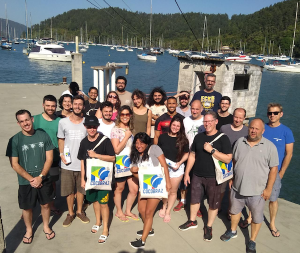 A thematic winter school was held in collaboration between the Laboratoire d’Océanologie et de Géosciences (LOG, Wimereux, France) and the spatial institute of Brazil (INPE). The winter school was organized within the framework of the Franco-Brazilian ANR FAPESP PRCI project Characterization of Brazilian coastal waters biogeochemical quality evolution over the last two decades from satellite observation: impact of natural and anthropogenic forcings (COCOBRAZ), led by V. Vantrepotte (Laboratoire d’Océanologie and Géosciences, LOG), M. Kampel (Instituto Nacional de Pesquisas Espaciais, INPE), and F. Brandini (Instituto Oceanográfico da Universidade de São Paulo, IO-USP). The training took place from 8 – 16 July 2023 at the Clarimundo de Jesus research base in Ubatuba, Brazil. This thematic school welcomed around twenty students and young researchers from various institutions across Brazil, spanning from the north to the south.
A thematic winter school was held in collaboration between the Laboratoire d’Océanologie et de Géosciences (LOG, Wimereux, France) and the spatial institute of Brazil (INPE). The winter school was organized within the framework of the Franco-Brazilian ANR FAPESP PRCI project Characterization of Brazilian coastal waters biogeochemical quality evolution over the last two decades from satellite observation: impact of natural and anthropogenic forcings (COCOBRAZ), led by V. Vantrepotte (Laboratoire d’Océanologie and Géosciences, LOG), M. Kampel (Instituto Nacional de Pesquisas Espaciais, INPE), and F. Brandini (Instituto Oceanográfico da Universidade de São Paulo, IO-USP). The training took place from 8 – 16 July 2023 at the Clarimundo de Jesus research base in Ubatuba, Brazil. This thematic school welcomed around twenty students and young researchers from various institutions across Brazil, spanning from the north to the south.
The main objective of the school was to provide both theoretical and practical sessions in the fields of marine optics and ocean color satellite remote sensing. It aimed to promote and encourage the use of these observation tools for various applications in oceanography, particularly focusing on Brazilian waters. Due to the great success of this first COCOBRAZ winter school, a second session is planned for 2025.
Materials available from the 2023 Ocean Optics Class
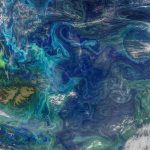 The training course Calibration & Validation for Ocean Color Remote Sensing (otherwise called the Ocean Optics Class) is an intensive, 4-week, cross-disciplinary, graduate-level workshop in Optical Oceanography held at the Bowdoin College’s Schiller Coastal Studies Center (SCSC), Maine, USA. The 2023 Ocean Optics Class was held from 12 June – 7 July. Information about Instructors, lectures, and lab materials are available here: https://misclab.umeoce.maine.edu/OceanOpticsClass2023/
The training course Calibration & Validation for Ocean Color Remote Sensing (otherwise called the Ocean Optics Class) is an intensive, 4-week, cross-disciplinary, graduate-level workshop in Optical Oceanography held at the Bowdoin College’s Schiller Coastal Studies Center (SCSC), Maine, USA. The 2023 Ocean Optics Class was held from 12 June – 7 July. Information about Instructors, lectures, and lab materials are available here: https://misclab.umeoce.maine.edu/OceanOpticsClass2023/
PANTHYR data release
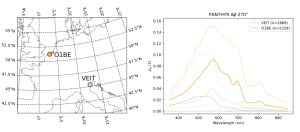
The spectral plot shows the median (solid line) and 1 and 99 percentiles of reflectance measurements at 270 relative azimuth to the sun for both sites.
Two hyperspectral water reflectance datasets have been released from the 2019-2022 deployments of a pan-and-tilt hyperspectral radiometer (PANTHYR) in the turbid waters of the Belgian coastal zone (Oostende, Vansteenwegen and Vanhellemont, 2023) and the transitional waters of the Adriatic sea (Acqua Alta Oceanographic Tower, Brando et al., 2023).
These datasets are useful for validation of atmospheric correction algorithms for any sensor bands between 400-900 nm without the need for spectral interpolation or band shifting. Application was demonstrated for multispectral sensors (Vanhellemont 2020, Vanhellemont 2023, Vanhellemont and Ruddick (2021), and hyperspectral satellites (Braga et al. 2022). Additional use cases could include development and analysis of retrieval algorithms as for Lavigne et al. (2023) where the in situ measurements alone showed the seasonal dynamics of phytoplankton with a spring bloom of Phaeocystis globosa followed by a summer bloom of other phytoplankton species. Access the github for the project here https://github.com/Panthyr
Featured Publications
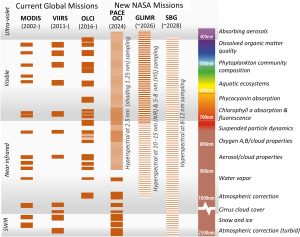 NASA plans to launch three new missions for monitoring aquatic ecosystems from space: PACE in 2024, Geostationary Littoral Imaging Radiometer in 2026, and SBG in 2028. Each mission monitors unique space and time scales from inland water quality to coastal habitats to upwelling zones supporting rich phytoplankton blooms. Having many more wavebands than historic sensors, these missions will allow us for the first time to monitor phytoplankton diversity from space. Dierssen et al. 2023 details the specifications of each mission in table and graphic format and provides an overview on data products, calibration, field campaigns, and synergistic research and applications across the aquatic continuum from land to open ocean.
NASA plans to launch three new missions for monitoring aquatic ecosystems from space: PACE in 2024, Geostationary Littoral Imaging Radiometer in 2026, and SBG in 2028. Each mission monitors unique space and time scales from inland water quality to coastal habitats to upwelling zones supporting rich phytoplankton blooms. Having many more wavebands than historic sensors, these missions will allow us for the first time to monitor phytoplankton diversity from space. Dierssen et al. 2023 details the specifications of each mission in table and graphic format and provides an overview on data products, calibration, field campaigns, and synergistic research and applications across the aquatic continuum from land to open ocean.
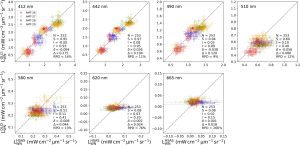 High quality independent ground measurements that are traceable to metrology standards, with a full uncertainty budget, are required for validation over the lifetime of ocean-colour satellite missions. Pardo et al, (2023) used normalised water leaving radiance in situ data, collected to Fiducial Reference Measurement standards during four Atlantic Meridional Transect (AMT) field campaigns from 2016 to 2019, to assess the performance of radiometric products from Sentinel-3A and 3B OLCI, MODIS-Aqua, and Suomi-VIIRS and NOAA-20 VIIRS using an uncertainty threshold for the in situ data. Three atmospheric correction models were compared for Sentinel-3A and 3B OLCI: OLCI IPF-OL-2, POLYMER and NASA SeaDAS l2gen. POLYMER showed the best performance. The Sentinel-3A and 3B OLCI instruments were also compared during their tandem phase, which showed that S-3B OLCI radiances were systematically higher than S-3A OLCI across the spectrum.
High quality independent ground measurements that are traceable to metrology standards, with a full uncertainty budget, are required for validation over the lifetime of ocean-colour satellite missions. Pardo et al, (2023) used normalised water leaving radiance in situ data, collected to Fiducial Reference Measurement standards during four Atlantic Meridional Transect (AMT) field campaigns from 2016 to 2019, to assess the performance of radiometric products from Sentinel-3A and 3B OLCI, MODIS-Aqua, and Suomi-VIIRS and NOAA-20 VIIRS using an uncertainty threshold for the in situ data. Three atmospheric correction models were compared for Sentinel-3A and 3B OLCI: OLCI IPF-OL-2, POLYMER and NASA SeaDAS l2gen. POLYMER showed the best performance. The Sentinel-3A and 3B OLCI instruments were also compared during their tandem phase, which showed that S-3B OLCI radiances were systematically higher than S-3A OLCI across the spectrum.
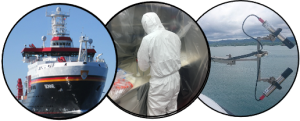 Browning et al. (2023) used hyperspectral observations of ocean colour made by shipboard radiometers in the Equatorial Pacific Ocean to derive underway chlorophyll fluorescence. When matched to satellite data, analysis revealed a correlation to sunlight stimulated passive fluorescence. An upscaling of the ship-based study was done using MODIS-Aqua observations of fluorescence over the last two decades. The team found phytoplankton iron limitation scaled with upwelling of deep-water iron, and estimated that a state-of-the-art ocean biogeochemical model overestimated phytoplankton iron limitation fluctuations 2-fold. Such field assessments are key for linking phytoplankton physiological information with satellite observations – particularly as a new generation of hyperspectral missions have been launched (e.g., PRISMA, EnMAP) and will be launched (e.g., PACE, CHIME).
Browning et al. (2023) used hyperspectral observations of ocean colour made by shipboard radiometers in the Equatorial Pacific Ocean to derive underway chlorophyll fluorescence. When matched to satellite data, analysis revealed a correlation to sunlight stimulated passive fluorescence. An upscaling of the ship-based study was done using MODIS-Aqua observations of fluorescence over the last two decades. The team found phytoplankton iron limitation scaled with upwelling of deep-water iron, and estimated that a state-of-the-art ocean biogeochemical model overestimated phytoplankton iron limitation fluctuations 2-fold. Such field assessments are key for linking phytoplankton physiological information with satellite observations – particularly as a new generation of hyperspectral missions have been launched (e.g., PRISMA, EnMAP) and will be launched (e.g., PACE, CHIME).
 The cyanobacterium Trichodesmium is responsible for approximately half of the ocean’s nitrogen input through nitrogen fixation. It was first recorded near Australia in the 18th century, yet our knowledge is still limited due to lack of observations. Using VIIRS imagery and a method to account for the spectral shape and spatial morphology of image features, Qi et al. (2023) quantified Trichodesmium surface scum around Australia. Ocean temperature, iron-rich dust and black carbon aerosols, with the latter being a result of frequent bushfires, appeared to play major roles in determining the spatial distributions and seasonality of Trichodesmium.
The cyanobacterium Trichodesmium is responsible for approximately half of the ocean’s nitrogen input through nitrogen fixation. It was first recorded near Australia in the 18th century, yet our knowledge is still limited due to lack of observations. Using VIIRS imagery and a method to account for the spectral shape and spatial morphology of image features, Qi et al. (2023) quantified Trichodesmium surface scum around Australia. Ocean temperature, iron-rich dust and black carbon aerosols, with the latter being a result of frequent bushfires, appeared to play major roles in determining the spatial distributions and seasonality of Trichodesmium.
In addition to these highlighted above, several new publications have also been added to the Ocean Colour Bibliography:
Employment Opportunities
Several new research and employment positions were added to Employment Opportunities section on the IOCCG website including:
- PhD Student Opportunity in Aquatic Biogeochemistry & Remote Sensing, Cleveland State University, USA
- Research Technician – Aquatic Biogeochemistry, Cleveland State University, USA
- Earth Observation Remote Sensing Scientists, Plymouth Marine Lab, UK
- Postdoctoral Fellow (Oceanographer), Khalifa University, Abu Dhabi, UAE
- Ocean Biogeochemistry Research Assistant, SSAI, Maryland USA
- Postdoctoral Scholar, Center for Marine Science, University of North Carolina Wilmington, USA
- Senior Scientist Ocean Colour, College Park, MD, USA
- Postdoctoral Research Associate, University of Exeter. UK
Click here For more information on these and other positions. If you would like to include a position on this page, please contact Raisha Lovindeer.

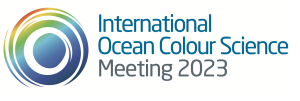

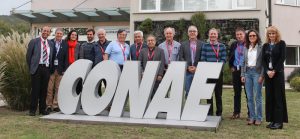
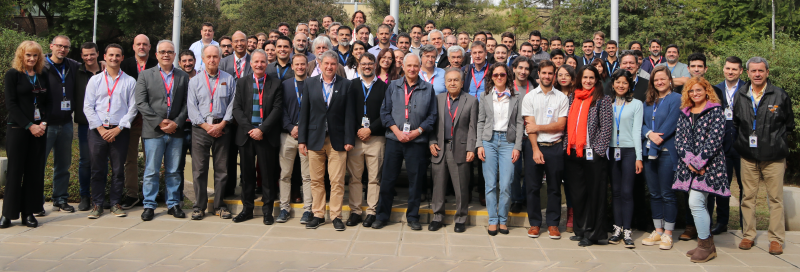
 The sixth International Ocean Colour Science (IOCS) meeting will take place in Darmstadt, Germany from 1 – 4 December 2025, hosted by EUMETSAT and ESA with support from other agencies.
The sixth International Ocean Colour Science (IOCS) meeting will take place in Darmstadt, Germany from 1 – 4 December 2025, hosted by EUMETSAT and ESA with support from other agencies.